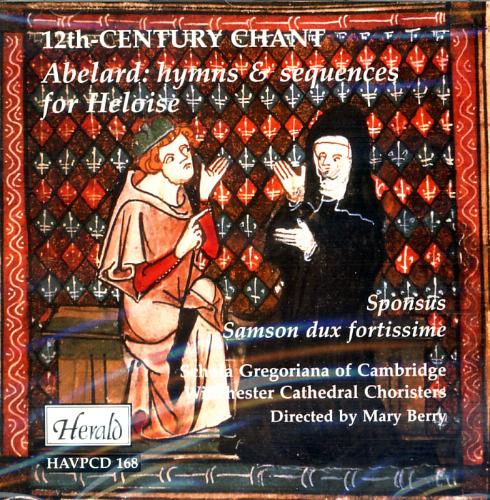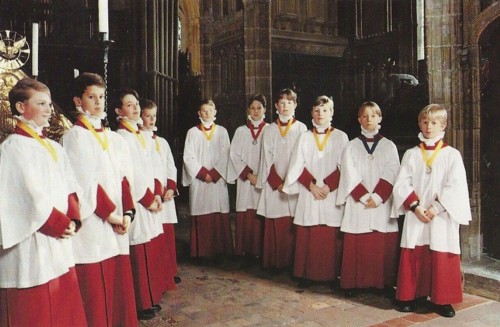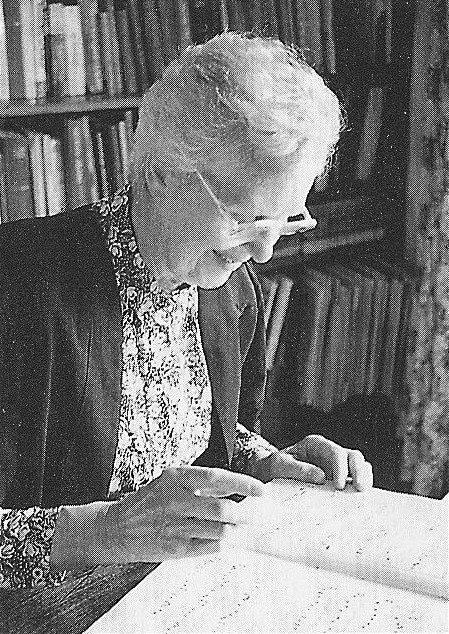

Peter Abelard (1079-1142) was one of the most famous scholars, poets, composers, and personalities of the era. Though a large volume of his writing survives, including many hymns, only a handful of his melodies have been reconstructed. In fact, until recently this handful was only two. Now there are a few more. While Hildegard is certainly more famous to us today (and indeed much more of her music has survived), Abelard had far more influence during his lifetime, and would have been the better-known figure only 20 years ago. Their musical styles are broadly similar. — medieval.org
Herald HAVPCD 168
febrero-mayo de 1993
1. ABELARD. O quanta qualia
[4:39]
g def
2. ABELARD. Dolorum solatium
[9:03]
e dfg
3. Suscipe [3:30]
Benedictine Ritual
g def
4. ABELARD. Mater salvatoris [2:21]
music, Cistercian 'Ave maris stella'
b ac
5. ABELARD. Ne derelinquas me
[3:29]
c ab
6. Sponsus [15:53]
Aquitanian liturgical drama
Winchester Cathedral Choristers · defg
7. ABELARD. Epithalamica
[7:27]
A sequence for Easter Day
Introduction · Song of the Bride / Psalm of the Maiden
Companions to the Bride
b ac
8. Magnum salutis gaudium [1:42]
Hymnus de Sancta Maria Magdalena, Cistercian
a bc
9. Quam pium [3:39]
St. BERNARD, Cistercian
e fg
10. Fulcite me floribus [3:27]
Matins responsory for a holy woman, from the Cistercian Antiphonale,
and dating form the time of the Bernardine reform of the liturgy
c ab
11. Dum esset rex [1:41]
Matins responsory for the Feast of the Assumption, from the Cistercian
Antiphonale,
and dating form the time of the Bernardine reform of the liturgy
a bc
12. ABELARD. De profundis
[11:17]
Peter Abelard's sequence for the departed
f deg
13. Samson dux fortissime [10:44]
medieval lai
London, British Library, MS Harley 978
g def
SCHOLA GREGORIANA OF CAMBRIDGE
Mary Berry
a Caroline Ashton · soprano
b Ruth Holton · soprano
c Olive Simpson · soprano
d John Bowley · tenor
e William Lee · tenor
f Michael McCarthy · bass-bariton
g John Rowlands-Pritchard · bass
Winchester Cathedral Choristers

PETER ABELARD, 1079-1142
"Two special gifts you had," wrote Heloise to Abelard years after their
tragic separation, "two special gifts whereby to attract straight way
the heart of any woman whomsoever: the beauty of your songs and your
singing ... Sung again and yet again for utter charm of word as well as
tune, they kept your name continually on the lips of everyone: the very
sweetness of the melodies ensured that even the unlettered would not
forget you."
Scholars have long suspected that at least a few or Master Peter
Abelard's love-lyrics may have found their way anonymously into the
songbooks or the later Middle Ages; but not a single melody
attributable to Abelard has proved recoverable. Most medievalists tend
to forget, however, that the tragic ending of the passionate
love-affair between the celebrated school-man and the young Heloise
marked the beginning of a new and even more profound relationship
between the two. From his monastery in distant Brittany, Abelard, now
Abbot of St Gildas, continued to write texts and melodies for Heloise,
now Abbess of the Abbey of the Paraclete on the other side of France,
near Troyes; and, in time, a sizeable body of Abelard's compositions
helped to give the liturgy of the Paraclete its distinctive note.
These compositions included a complete Holy Week Office, collects,
responsories, antiphons, sequences, sermons, even a biblical lectionary
arranged by Abelard. But though the texts of these compositions were
recoverable, the accompanying melodies were not, apart from a few
tantalizing exceptions. A large collection of Abelard's hymns had
survived in two manuscripts (a non-noted hymnary, Bruxelles,
Bibliothèque Royale 10147-10158, late 12th century or early
13th; and a non-noted Paraclete breviary, Chaumont, Bibliothèque
Municipale 31), and an occasional hymn had appeared in other
manuscripts; but only in one instance, the Saturday Vespers hymn O
quanta qualia, was the melody recoverable, thanks to a few Swiss
manuscripts. Six non-liturgical but biblically-inspired planctus
(laments) had similarly survived complete with staffless neumes
(Biblioteca Vaticana, Reg. lat.288); but the absence of a stave
rendered the recovery of the melodies conjectural at best—apart
from the single 'Planctus', David's lament for Saul and Jonathan, which
is also known in a version with staff notation, but in a manuscript of
dubious quality (Oxford, Bodley 70).
Fortunately, in 1957 the noted musicologist Michel Huglo, succeeded in
identifying yet another version of David's lament in an earlier and
much better manuscript (Paris, Bibliothèque Nationale, n.a.
lat.3126), a prosary from Nevers. In fine, the extent of Abelard's
recoverable music was limited to a single hymn-melody and a single
planctus.
All this changed in the early 1980s when a monk of Gethsemani Abbey
(Kentucky, U.S.A.), Fr Chrysogonus Waddell, began working on an edition
of the liturgical manuscripts of the Abbey of the Paraclete. These
manuscripts included a late 13th-century Old French liturgical
directory (Paris, Bibliothèque Nationale franc.14410) containing
numerous references to liturgical sequences. Since Abelard himself had
once referred to a collection of his sequences sent to Heloise and her
sisters along with a collection of hymns, was it possible that the
sequence-references in this Old French manuscript might point to some
of the lost sequences of Abelard? A careful study of this repertory of
some 60 sequences (of which a half-dozen remain unidentifiable) brought
to light a group of three, remarkable for their textual correspondences
with Abelard's hymns, sermons and letters. The strophic forms and
peculiar rhyme-schemes were those of Abelard's hymns. The techniques of
composition, the similarity of many of the melodic incises, and the
treatment of accents and word-endings in relationship with the melody,
all pointed to a single composer. It could hardly have been
coincidental too, that these three sequences are found grouped together
in the above-mentioned prosary from Nevers, and in immediate
juxtaposition with Abelard's planctus for Saul and Jonathan. Further
research resulted in the identification of numerous manuscripts and
even printed sources for both texts and melodies—proof that at
least a few of Abelard's sequences had found their way, albeit
anonymously, into liturgical books of France, Switzerland, and even
Germany.
Heloise's admiration for Abelard's musical and poetic talent is
understandable. One only has to consider a single example: that
Saturday Vespers hymn O quanta qualia. The vision of heaven is
ecstatic and the tune so well constructed that phrase succeeds phrase
organically and seemingly inevitably. Abelard's little Marian hymn Mater
salvatoris addresses the Mother of the Saviour in familiar, almost
naïve terms. As it appears to lack an original Abelardian tune it
is sung here to the Cistercian form of the 'Ave maris stella' with
which, like most of Abelard's Marian hymns, it shares the same 6666
trochaic metre.
Abelard's planctus for Saul and Jonathan Dolorum solatium
reveals a depth of feeling that must surely be related to the state of
utter despair in which he found himself after his parting from Heloise.
Reading between the lines one may, perhaps, perceive Heloise behind the
figure of Jonathan. Each of the lovers went their respective ways
towards the cloister and would have shared, at a distance, the singing
of the Suscipe, a chant that a monk or a nun sings at the
moment of solemn profession. When later, by a curious quirk of
circumstances, Heloise became Abbess of the Paraclete and Abelard the
spiritual director of the nuns, he asked them to pray for him at each
Hour of the Divine Office, composing for this purpose the moving
responsory Ne derelinquas me. The liturgy at the Paraclete,
basically Cistercian, was greatly enriched by Abelard, who introduced a
wider use of biblical texts. Two of his newly-identified sequences,
written for the Paraclete, are his Easter sequence Epithalamica,
and his sequence for the dead De profundis. Epithalamica,
strongly inspired by the Song of Songs, sees the drama of the
Resurrection as re-enacted in the life of a Paraclete nun, herself a
Bride of Christ, awaiting the Bridegroom's return from the tomb. De
profundis is of particular interest musically, in the way it uses
different areas of the diatonic scale. It moves gradually across from
the descending phrases of lamentation in Mode 2 to the hope and
serenity suggested by the rising phrases the composer chooses for the
ending in Mode 8.
Abelard's musical output may be usefully assessed when seen against the
background of other contemporary sources. One of the best-known to him
must surely have been the repertoire produced by the reforming
Cistercians under the guidance of his adversary St Bernard. The
Bernardine reform extended the original very restricted repertoire of
office hymns to include others of such delightful freshness as the one
in honour of St Mary Magdalene Magnum salutis gaudium. Bernard
himself composed a proper Office for the Canons regular in honour of St
Victor, from which has been taken as an example the short antiphon Quam
pium, with its spontaneous leaps, use of melisma and sense of
overall form. Bernard, like Abelard, makes constant liturgical use of
the Song of Songs, a book traditionally used by Christian spirituality
to represent the love of Christ for the Church and for the individual
Christian soul. Fulcite me floribus, the fourth Matins
responsory for Feasts of Virgins, and Dum esset rex, tenth
responsory for the Feast of the Assumption, show the musical
development of this idea in the liturgy of the early Cistercians.
Another fascinating contemporary or near contemporary composition for
comparison is the Aquitanian liturgical drama Sponsus (Paris,
Bibliothèque Nationale MS lat.1139), which tells the story of
the Wise and Foolish Virgins, half in Latin and half in the Occitan
vernacular. It contains four melodies, characterizing the various
dramatis personæ. Ecclesia has a straightforward Mode 8 melody,
falling into clear-cut metrical patterns. When at the end of the drama
the Bridegroom, Christ, finally arrives, he shares the same tune. The
Archangel Gabriel sings a more elaborate tune, each strophe of which
ends with a word of warning that the Virgins must be vigilant: "Don't
fall asleep!" The melody of the Foolish Virgins, shared by the worldly
merchants, exploits the eschewed tritone and ends indecisively. The
fourth melody, that of the Wise Virgins, is the most highly-developed.
Each strophe is followed by a refrain of complaining by the Foolish.
The message of condemnation at the end of the drama has been ascribed
here to Gabriel, since it is sung to his melody, though no rubric to
this effect actually exists in the manuscript. Indeed, missing rubrics
are not infrequent in other places as well.
More dramatic, perhaps, than Sponsus, with its stylized
characterization, is the medieval lai Samson dux fortissime
(London, British Library, MS Harley 978). Samson, a figure of Christ,
who triumphed at the moment of his Passion, was a favourite hero of the
medieval Church (Judges 14, 15, 16). We are well prepared for the
unfolding of the drama by its powerful opening, achieved by the
simplest of means: the Chorus prepares Samson's dramatic entry—on
the highest pitch of the chosen range—by the simple addition of a
repeated phrase, heard four times over instead of three. This splendid
piece has much affinity and indeed certain precise features in common
with the Abelardian sequences, not least the use of such passages as
those involving textural crossings-over at the climax: "Ludens lugebam,
plaudens plangebam, risi piangendo, lusi plorendo ... Glorianter
crucior, crucianter glorior" with its direct reference to Christ's
Passion, and which may be compared with Abelard's "Risi mane, flevi
nocte; mane risi, nocte flevi ... Plausus die, planctus nocte; die
plausus, nocte planctus" at the moment of Christ's Resurrection.
© 1994 Fr Chrysogonus Waddell, OCSO and Mary Berry
